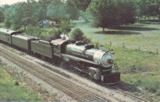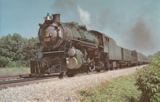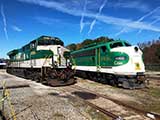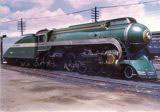
The Southern Railway,
a.k.a. the Queen and Crescent,
a.k.a. The Cincinnati,
New Orleans, and Texas Pacific Railroad ( C.N.O. & T. P.)
The C.N.O.& T.P. #8, early on.
The C.N.O.& T.P in Lexington, July 22, 1927
 |
 |
Both of these steam engines are posed for their picture at Ludlow. |
The C.N.O. & T. P., unknown location
 |
 |
Southern 2255, an EMD NW2 Switcher |
Southern Railway Scene, a pair of FP-7's |
Southern Railway RS2, 1949
Southern Diesels, unknown location
Designed for The Tennessean (Wikipedia)
A design by Otto Kuhler (Wikipedia)
 |
 |
 |
 |
 |
| 610 | 610 | 4504 | 4501 | 4501 |
The Southern ran these two locomotives as excursions in the 1970's and 1980's, long after they had retired.
And if you've never seen a locomotive like the 610 at full speed, with tons of rotating steel making
a furious noise, spouting steam and cinders, and propelling tons of cars behind it faster than speeding
cars can keep pace in a veritable continuous explosion of iron and steel on wheels, you've missed one of the
really great sights of the 20th century, and you'll come up short trying to understand the romanticism and
the lure of the rails in 19th and 20th century America.
C. N. O. & T. P. circa 1890's
 |
 |
 |
| Mikado (2-8-2) No. 16350, used by the C. N. O. & T. P. |
Locomotive No. 1396, used on the Crescent Limited |
4-8-2 Mountain-type passenger locomotive number 1463. |
Flagship passenger trains had names, and they were a class above the every day trains most
people took, in service, class, and speed. The Crescent Limited was one of Southern's fastest.
They also ran,
among others, the Carolina Special, the Royal Palm, the Ponce de Leon, the Southerner,
and the Pelican. In those days, a railroader could lose his job for anything that caused one of these
high-profile named-trains to fall behind schedule.
![]()
The Southern Railway Historical
Society is here.
![]()






